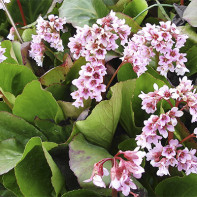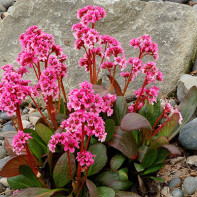Bergenia: medicinal properties and contraindications
Extraordinary beauty, unpretentiousness, frost resistance Bergenia (Bergenia) - the dream of all florists and gardeners. This plant ennobles garden plots, add a touch of elegance to bouquet compositions. Despite the fact that Bergenia is a favorite of gardeners, this plant is more often found in the wild. The stony soil of Central Asia, Kazakhstan, and China abounds with this perennial evergreen bushy plant with delicate lilac flowers.
- Chemical composition
- How it looks and where it grows
- Types of
- Harvesting and storage
- Bergenia care
- Bergenia curative properties
- For Women
- For Men
- In Pregnancy
- For Children
- Bergenia in folk medicine
- Endemic goiter therapy
- Rhinitis prevention
- Water extract from crushed Bergenia rhizomes
- Bergenia Leaves Healing Decoction
- Treatment of dysentery
- From stomatitis and periodontal disease
- A styptic
- Bergenia in the prevention of duodenitis
- Baths from decoction of Bergenia root with hemorrhoids
- Compresses
- Bergenia Bergenica uses in cooking
- Types of medicinal compositions
- Infusion
- Tincture
- Decoction
- Bergenia tea (Mongolian tea)
- Powder
- Cosmetic applications
- Contraindications to use
Bergenia grows not only in the front gardens of beauty connoisseurs, but also in the plots of adherents of folk healing. Because of its medicinal properties, it occupies one of the main places in the medicine cabinet of alternative medicine.
Chemical Composition
The chemical composition of the evergreen badanum is quite complex. Bergenia concentrates about 20-30% of tannins, which are concentrated mostly in the branched rhizome of the perennial. As the plant grows, the concentration of these substances increases.
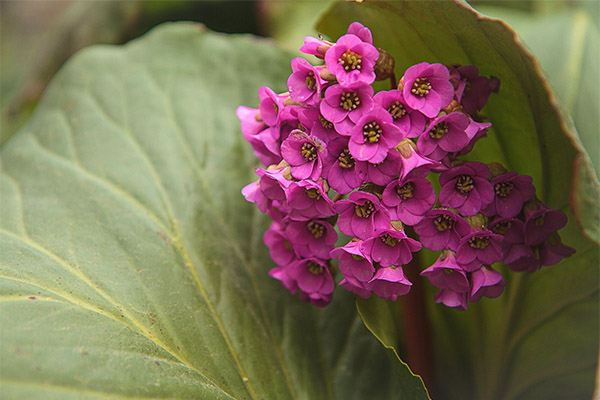
The leaf leaves contain significant amounts of tannides, arbutin, hydroquinone, ellagic acid, and gallic acid.
The half-meter bush of badanum concentrates many chemical substances, among them carbohydrates, catechins, vitamins, flavonoids, essential oils, resins, starch, sugar, bergenin, dextrin, minerals.
What it looks like and where it grows
Perennial badanum because of its pharmacological properties is classified as a group of medicinal plants. The maximum height is 0.7 m. The root is deep brown in color, creeping, branched, and arranged horizontally. The thick stem is colored pink or pale red.
The leaf plates of badanum can be either rounded or oval, glossy or matte - the shape and texture depends on the variety of badanum. The plant has deep green root leaves. Brushes of inflorescences are formed of lilac or light pinkish flowers, arranged on oblong petioles. Bergenia seeds are hidden in oval capsules with divergent lobes. The fruits are small, black.
Most varieties of badanum bloom in summer, but there are species that start blooming in early spring. Bergenia usually grows on mountain slopes, scree and in cedar forests. Bergenia is a very undemanding plant, likes shade and damp places, and tolerates frosty winters well.
Species
The varieties of badanum differ from each other by the size of the stem, the size and shade of the inflorescences. The species of this plant are differentiated by the type and color of the leaves. Sometimes there are completely unique specimens with non-traditional shades of flowers, with velvet and semi-velvet texture. Each type of badanum blooms at different times, differing from each other in effectiveness.
Gardeners have a greater preference for holly. It is this species is considered the most optimal for cultivation. In the top three in terms of popularity also include the holly and the Pacific.
Thick-leaf Bergenia (Bergenia crassifolia)
Thick-leaf Bergenia is often called the medicinal, variegated, chagyr or Mongolian drink. This variety is famous for its extraordinary medicinal properties. This species grows in the cedar forests and mountain slopes of the Altai, Sayan, Transbaikalia, Kazakhstan, China, and Northern Mongolia - it can be found all over the world. A strong branched rhizome, a leafless or rosette stem, and bright green leaves are the traditional appearance of this perennial evergreen plant. In the fall season, the leaves of badanum are transformed by taking on a deep red color. Pink-lilac or purple-purple flowers bell-shaped form lush inflorescences almost 120 mm long.
Badanum thickifolia usually blooms in June and lasts a month. Blossom ends in mid-July. Strawberry is widely used among lovers of natural herbal teas. A useful decoction is made from leaves collected in the spring. In addition, holly-leaf Bergen is popular among craftsmen in leatherworking, who find the use of the plant in their craft.
Bergenia cordifolia
Bergenia cordifolia is not a genus in its own right but is rather a species of Bergenia thickleaf. However, these plants are very different from each other. The heartleaf type grows to almost half a meter tall. The leaf laminae are dark green in color and quite hard to the touch. The inflorescences themselves are tassel-shaped. The light lilac or pinkish flowers resemble bells. Among Bergenia cordifolia there are also rare specimens that differ from the rest of the group by the white color of the inflorescences.
Bergenia hissarica
Bergenia hissarica is considered the rarest and most ancient type of Bergenia. It grows exclusively on the expanses of the Hissar range. The herbaceous shrub has a very strong, branched rhizome. The leaves are oblong, smooth and matte. A twenty-centimeter flower stalk usually bears 7-9 light pink flowers, which form a medium-sized inflorescence.
Ledum Galina Serova
Budana Galina Serova has not only a curious name, but also an unusual color of the leaf plates - it is mottled. It usually blooms very early - the first clusters of lilac or pale pink flowers appear as early as early May. By the middle of June flowering ends. However, Bergenia does not lose its decorativeness because of the large embossed leaf plates, which turn fiery red by the beginning of autumn.
Bergenia Bressingham White
This variety of badanum is a lover of shade and moisture. It is characterized by unusual, lacquered-looking leaf plates, characterized by good frost resistance and unpretentiousness.
Stretchy's Bergenia gorbunowii
Stretchy's Bergenia gorbunowii is a high-altitude plant. It can be found on the tops of mountain ranges of the Himalayas, China, Central Asia and Afghanistan. The plant is incredibly rare, relict, can grow even at an altitude of 3 km above sea level. And the snow is no obstacle for it. Leaf laminae feel fine even under an impressive layer of winter precipitation. There are several varieties of this plant - Beethoven, Belvedere and Alba. Belvedere is one of the shortest types of this plant, reaching a height of only 0.2 m. The variety, named after the talented composer, is characterized by pinkish-colored flower stalks and brushes with snow-white inflorescences. And the white flowers of Bergenia Alba are very rare in nature.
Very often badanum is planted in homestead plots for beauty. For decorative purposes, the most common varieties are Bergenia senor, Purpurea, Guideruspe. The last species is a record-breaker among badans in terms of flowering - pleasing to the eye for 9 weeks.
Bergenia has also been the subject of breeders, who have created several hybrid species of this plant. Sieberlicht, Schneekenigin, Bassingham White, Morgen Rothe, Pink Dragonfly, Baby Doll, Walter Kinley, Frau Holle, Sunningdale, Abendglut - the imagination of gardeners has no limits. There is an interesting trend - badanum varieties are named after legendary composers of the past. In the front gardens of sophisticated gardeners you can find Bergenia Borodin, Bizet, Brahms, Bach, Bartók and others.
For example, the leaves of Badanum Frau Holle have a marsh color, and when the first cold weather arrives, the leaf petioles are colored a delicate purple. At the same time, the inflorescences themselves are crystal white. Bergenia Morgen Rothe is unique in that in one season it can please gardeners with flowering as many as twice. Inflorescences of Badanus Baby Doll pink by the end of the process of flowering are colored in a rich cream color. Bergenia schnee kenigin is famous for its volume. It is a truly bogatyr variety of badan - half-meter stem, large leaf plates, long flower stalks, voluminous flowers. And Bergenia Abendglut is a real harbinger of autumn: at this time of year the flowers of the plant turn deep brown.
Harvesting and storage
Badanum is very appreciated among the adherents of folk medicine, so this plant is planted not only for beauty in the household plot, but also for further use in the prevention of various diseases. The stem and inflorescences, as a rule, are not used in alternative medicine. But the rhizome and leaves of Bergenia have a certain value because of the pharmacological properties of the plant.
Bergenia is a perennial plant, but the collection of roots begins in the summer season. This process is not automated. Bergenia root is harvested by hand. After collecting the rhizomes are thoroughly cleaned and even washed with water. Too large roots are cut lengthwise.
Next comes drying, which is carried out necessarily in the open air, under a tent or awning of the household room. If there is no such a possibility, a well-ventilated room is suitable for drying roots. However, the most convenient option remains specialized drying machines, which are sold in home appliance stores or hardware stores. The main thing is to observe the temperature regime. The optimal temperature is 30-45 ° C.
If you dry the roots according to the above algorithm, badanum can be stored in good condition for about five years, but no more. Dry bergenia roots are very fragile and have, as a rule, astringent notes in the taste. It is better to keep the plant in thick cardboard boxes or in dry, closed wooden boxes.
Leaves of badanum should be collected immediately after the snow melts - in early spring. Only the blackened, perennial leaves are worth picking. They can be used in alternative medicine as a raw material for decoctions and infusions. Dry in the same way as the roots, - in the open air. Store better in cloth bags or paper bags for not more than 1.5 years.
Care for Bergenia
Bergenia is one of the most unpretentious plants. This perennial calmly tolerates both sharp temperature changes and strong frosts. Even winter precipitation does not matter to it.
Plants, lovingly grown by gardeners, still require minimal care. In the autumn, the owners of household plots remove wilted inflorescences, and with the onset of spring - remove dry leaf plates. In the first year of flowering bergenia, the soil needs protection, which gardeners achieve through mulching. Excessive watering does not like Bergenia. The main thing is not to allow the soil to dry out. Also, the plant can be pampered with fertilizers and mineral fertilizers.
In the care of Bergenia has another important nuance: the plant poorly tolerates transplants, so it is better not to touch it unnecessarily. In one place bergenia can perfectly grow for decades.
Medicinal properties of Bergenia
Bergenia is widely used in folk medicine, being among the most useful plants. Infusions, decoctions and teas of Bergenia are a treasure trove of healing properties. Bergenia medicines stop blood flow, reduce inflammation, lower blood pressure, relieve headaches and migraines, strengthen vascular walls, heal wounds, improve immunity.
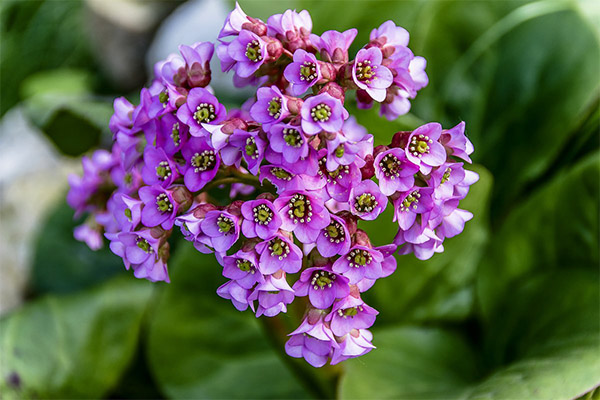
Medicinal preparations from bergenia are prepared as an adjunct to specialized drugs in the treatment of whooping cough, dermatosis, hemorrhoids, rheumatoid arthritis, pneumonia, gastritis, laryngitis and uterine fibroids.
For women.
Badan as a medicinal plant is very popular among women, as infusions and decoctions from it help to cope with many gynecological ailments. For example, specialized treatment of cervical erosion, inflammation of the appendages, cystitis and myoma can be complemented by sprinkling with badanum decoction. The recipe is quite simple. 5 tablespoons of fermented plant pour a glass of boiling water. After half an hour of being on a water bath, strain the solution. Such sprinkling should be done in the evening for 1.5 months.
When the menstrual cycle is heavy or painful, it is advised to take a small amount of badanum extract.
And, of course, the unique properties of Bergenia found use in the field of cosmetology. Bergenia is used in plant mixtures to combat acne, constrict enlarged pores and treat seborrheic dermatitis.
For men.
Bergenia is often called "the herb of real men". After all, decoctions and teas from this plant contribute to the strength of men. To achieve a more pronounced effect, intermingled with an extract of ginseng, St. John's wort and decoction of the golden root.
In Pregnancy.
Both children and pregnant and lactating women are better to limit the use of badanum. Because of the tannins in the composition of bergenia can cause constipation. Also decoctions, infusions and teas from this plant significantly lower blood pressure.
For children
Can Bergenia be beneficial not only for adults, but also for children? Medicines prepared from Bergenia are good for the prevention and therapy of children's diseases. However, in this case, it is necessary to pay attention to the nature of the ailment.
The substances contained in the leaves and rhizome of Bergenia, in some cases, can be beneficial, and in others - even harmful. Therefore, decoctions of plant origin can be given to a child only after the age of seven years.
Bergenia is good to cope with diarrhea in children. Prepared, fermented leaves bergenia crush and for 20 minutes insist on boiling water. In the resulting remedy, add honey. Take such an infusion in the morning and evening as an analogue of the usual leaf tea.
Bergenia in folk medicine
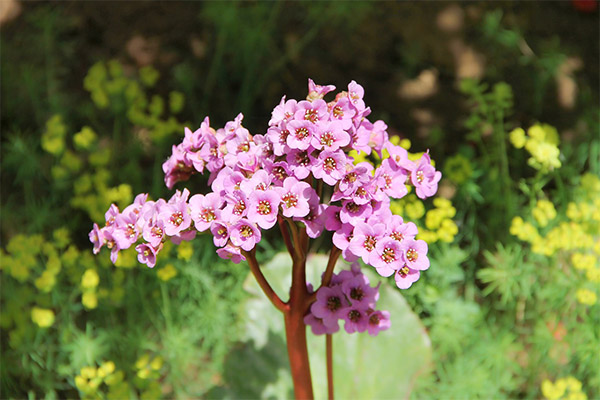
Endemic goiter therapy
For the prevention of endemic goiter, prepare a decoction of dried, finely fermented leaves of Bergenia. For this medicine, last year's blackened leaf plates are more suitable. The recipe is simple enough. Pour half a liter of boiling hot water over the leaves, insist. The resulting mass is placed on the stove and cook over low heat for about 0.5 hours. This decoction should be used in the form of tea. Drink it at least 4 times a day.
Rhinitis prevention
Badanum is often used in the treatment of inflammation of the nasal mucosa. For the prevention of rhinitis, it is better to use not pure badanum decoction, but a tincture of the plant mixture. St. John's wort and elecampane will do an excellent job. All herbs should be well ground and thoroughly mixed. For 30 grams of crushed herbal mixture take 450 milliliters of boiled water. Stir the ingredients and simmer over low heat for half an hour. The remedy is ready after infusing for a day in a warm place. Take a tincture of 40 milliliters 2 times a day.
Water extract from crushed radish rhizomes
Mix 5-6 tablespoons of crushed radish root with 500 milliliters of boiling water. The mixture to simmer over low heat until half of the broth boiled. The remaining decoction to infuse for 40 minutes and strain. The resulting extract rinse your mouth to prevent inflammation of the gums.
Healing Decoction of Leaves of Bergenia
Bergenia is a truly miraculous plant. Infusion of its leaves can have a good auxiliary effect in the treatment of enterocolitis, problems with gastrointestinal function, furunculosis, tuberculosis, angina, pneumonia and rheumatism. The medicine from this evergreen perennial bushy plant has a wide range of effects. Bergenia can be used to prepare a remedy that has a cleansing, anti-inflammatory effect. All you need to do is to take two ingredients - badanum root and water. 50 grams of dried crushed plant pour water and boil. On the stove the medicine should simmer for at least 30 minutes. Cooled and filtered medicine should be taken 30 milliliters three times a day.
Treatment of dysentery
At the first symptoms of infectious intoxication, it is necessary to seek help from specialists and adhere to appropriate treatment. Also a good help in the treatment of dysentery will be an infusion of badanum roots. Several spoons of fermented bergenia fill 400 milliliters of hot water and insist for 5-6 hours. The resulting remedy strain through a special sieve or simple gauze. The medication is ready to use. 20 grams of infusion take 3 times a day. The treatment course should be continued for two weeks.
From stomatitis and periodontal disease
Stomatitis is characterized by ulcerative and aphthous lesions in the mouth. To prevent the disease, treat and eliminate the effects of stomatitis, it is better not only to adhere to specialized treatment, but also to use folk medicine. Infusion of dried radish roots is an excellent aid in the treatment of stomatitis and periodontal disease. Raw material consisting of 4 spoonfuls of crushed bergenia, pour boiling water, insist 30 minutes. After the filtration process, the remedy is ready for use. The medicine should be rinsed around the mouth before and after meals several times a day.
A styptic
Lapworte root, licorice, bloodwort, snake's wort, badanum - an excellent herbal mixture for stopping bleeding. At first glance, hard-to-find ingredients are very easy to find in any pharmacy. All herbs need to be crushed, but in the pharmacy they are usually sold already in fermented form. Boil the herbal mixture with 500 milliliters of boiled water. Allow the medicine to infuse for a while. The next step is to boil for an hour over medium heat. From time to time it is necessary to stir the broth.
The final chord is to strain the resulting medicine. The algorithm for using the decoction is also uncomplicated. The remedy to drink 1/3 cup 5 times a day.
Badanum in the prevention of duodenitis
Inflammation of the duodenum lends itself well to prevention with a decoction of an herbal mixture, which includes crushed leaves of Bergenia, calendula, linseeds and oak bark. Pour 2-3 spoons of this herbal mixture with boiling water and insist for 12-14 hours, until a concentrated infusion is obtained. Drink the remedy in small portions throughout the day. The treatment of duodenitis should be supplemented with such decoction for 2-3 weeks.
Baths with decoction of radish roots for hemorrhoids
To prepare this solution will need:
- 50 grams of crushed roots of perennial;
- Half a liter of boiled water;
- St. John's wort;
- tansy;
- thermos.
Hemorrhoids are a sensitive disease, and going to the doctor should not be delayed. However, if you catch it in time and apply the heavy artillery of alternative medicine, a visit to a specialist and the unpleasant consequences of the disease can be avoided.
Dried St. John's wort, tansy, fermented badanum root should be well mixed in a container. The resulting herbal mixture to transfer to a thermos and pour boiling water. After 2-3 hours the infusion will reach the desired consistency, pour it into a bowl with moderately warm water. Take a bath for 15 minutes. The procedure is carried out several times a week.
Compresses
In the treatment of bruises, ulcers, wounds and bruises, you can use badanum compresses. Prepared in advance with a concentrated infusion of roots of perennial need to moisten a gauze bandage and apply to the sore area of the skin for 20 or 30 minutes. The procedure is better to repeat several times a day until healing is complete.
Using radish in cooking
Bergenia is used to make medicines, facial masks and tonics, to make tea and even to cook food. The leaves of badanum growing from three years old contain 5% fructose, 16% fiber. There are species where the percentage of fiber exceeds 20. The plant also contains simple protein, expressed by albumin and globulin.
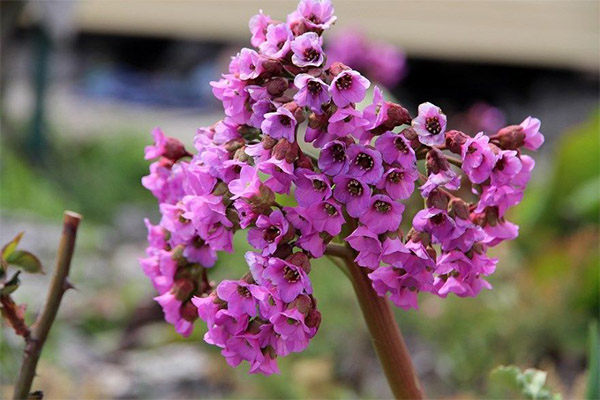
Rhadan root, cooked in different ways, can be found on the table of a sophisticated gourmet. Bergenia is also eaten by those who are committed to proper nutrition. The root of this plant is an excellent dietary dish that helps to lose weight.
Often the rhizome of this herbaceous perennial is ground into flour, which turns into a delicious and healthy baking. Bergenia roots are fried, steamed and boiled. Bergenia is often an ingredient in soups and side dishes. More often, however, everyone makes a tea from bergenia - a delicious, fragrant, fragrant tea.
Lingonberry tea with badanum
Lingonberry is a medicinal berry. It is often consumed to enrich the body with vitamins and minerals. However, few people know that lingonberry leaves are no less useful. Diabetics and people suffering from urolithiasis resort to their medicinal effects. If lingonberry leaves are brewed with badanum, the effect of the drink will be doubled.
Recipe:
2 tablespoons of badanum, a pinch of oregano and a handful of fermented lingonberry leaves combine in a saucepan and pour 500 milliliters of water. When the mixture comes to a boil, take it off the stove and let it cool. After an hour, strain the tea.
The pronounced taste of lingonberry and melon tea can be emphasized with a teaspoon of honey. It is a treasure trove of vitamins and useful substances in one cup. However, people suffering from gastrointestinal disorders should give up this drink.
By the way, lingonberry leaves in the above recipe can be replaced by blueberry, cloudberry, currant or strawberry leaves.
Types of medicinal compositions
Infusion
Angina, colds, bleeding gums, dermatological diseases - in such cases, an infusion of badanum leaves will come to the rescue. Finely chopped leaf plates brewed with boiling water in the proportion of 2 cups per 1 tablespoon. Insist for a day. Take 1 teaspoon 2-3 times a day.
Badanum infusion can treat abrasions and wounds on the skin surface. To do this, soak a cotton swab in the product and gently wipe the damage.
Tincture .
Therapeutic potion from badanum on the basis of alcohol is prepared for the treatment of bronchitis, acute respiratory infections, influenza and even pneumonia. In addition, alcohol infusion of Bergenia - an indispensable tool for warming compresses and rubbing the joints.
The algorithm for preparing the tincture is as follows:
- Take a glass container. 50 grams of crushed badanum root pour 150 grams of alcohol, moonshine or vodka.
- The vessel tightly corked with a lid and put in a dark dry room for 14-16 days.
- After infusion filter the remedy. Strain the medication diluted in a glass of clean water. Proportion - 25 drops per 300 milliliters of water. Drink 3-4 times a day.
Decoction .
To prepare decoctions, most often badanum roots are used. The main thing - select thoroughly dried outdoors or in a well-ventilated room rhizomes. Healing potion is brewed quickly and without much effort. Most often, its preparation takes no more than 30 minutes.
Badanus grind thoroughly, if you want - even grind it into a powder. Simmer 4 large spoonfuls of fermented plant over low heat with 500 milliliters of water. After half an hour of cooking, strain the decoction through a strainer and cool. It is not necessary to use the refrigerator for this purpose. You can leave it for a few hours at room temperature. Decoction is very rich and concentrated, so it is better to drink it in diluted form. A tablespoon of medicine to take 2 times a day before meals.
Decoction of badanum is a real panacea in the fight against gynecological diseases, problems of the gastrointestinal tract and hemorrhoids. You can drink the decoction as a prophylactic for colds and acute respiratory infections.
Tea from Bergenia (mongolian tea)
Bergenia is a unique plant. It delights the eye in the garden, treats from a variety of ailments and even gathers the whole family for an evening tea party. Bergenia tea is not only delicious but also very useful.
Badanium tea not only enriches the body with microelements and essential vitamins, but also speeds up the work of the intestines, strengthens the immune system, relaxes and tones up. However, do not drink this drink in large quantities, otherwise it can be fraught with low blood pressure, the occurrence of constipation and even tachycardia.
How to brew this tea? The recipe does not differ much from the algorithm for brewing ordinary tea. However, there is a nuance - it takes much longer to brew badanum tea so that the beverage is properly infused.
Moreover, badanum tea is also called mongolic or chigir tea. There are many ways to prepare it, but the most popular is the classic recipe.
To make a classic chigiri beverage uses only leaves. Such tea is not infused, but boiled. Fermented radish should be thrown in water, bring to a boil and leave for 30 minutes. Next - as usual. The resulting decoction dilute with boiling water. You'll get a tea with a rich, bright flavor.
Powder
Badanum powder is made mainly from the roots of this perennial plant. It has remarkable healing properties. It is not uncommon even for dermatologists who prescribe professional remedies to advise patients to turn to badanum powder as well. Healing burns, ulcers, wounds and other skin lesions need only be sprinkled with healing powder. As a rule, the effect is immediate.
People suffering from dermatological diseases often turn to compresses of badanum powder. Make it as simple as possible. Powdered mixture should be diluted with warm water and stirred to a homogeneous, thick mass, which and smear the sore spot. On top put a cotton pad or gauze. The final - fixation of the compress with a bandage.
Cosmetic applications
Lots of lotions, masks, tonics, tinctures and lotions - all this is done from badanum lovers of natural cosmetic products. Means from perennial are popular in the fight against oily shine, seborrhea and acne. With the help of badanum representatives of the fair sex overcome acne, subcutaneous inflammation and black points. Enlarged pores? It is not a problem for Bergenia tonic
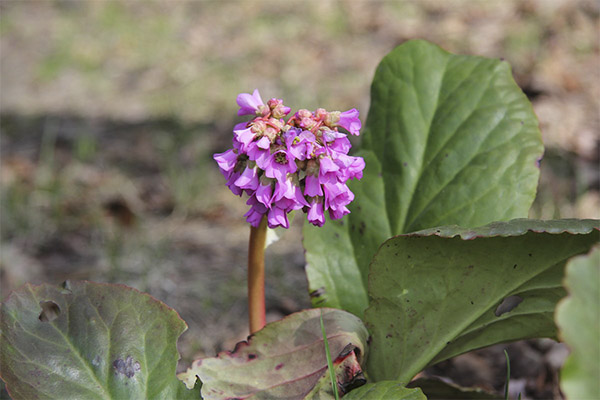
Bergenia tonic preparation algorithm
Tender, smooth, silky skin without any problem rashes - the dream of every girl. Achieve it will help tonic remedy from Bergenia. It can be made your own at home. The ingredients are very simple:
- 150 grams of vodka;
- pure water;
- radish roots;
- inflorescences;
- leaf plates.
The first step is to boil badanum in boiling water. After the infusion cools, add vodka to it. Insist the resulting mixture for 5-7 days. At the end of the specified period to filter the concentrated mass. That's all, the tonic is ready to use. After washing, wipe your face, neck and cleavage area with a cotton pad. Within a few weeks the effect will be noticeable - clean, rested, moisturized, toned skin without acne and acne.
Recipe for an oily skin care tincture
Mix crushed bergenia root with vodka in the proportion 2:8. Allow the infusion to come to the right condition in a dry, dark place for 5 days. However, during this time it should not be forgotten. You should shake the container with the lotion periodically. When the product is ready, do not hurry to use it. The tincture should be diluted with warm water in a ratio of 1:1. Dip a napkin in the resulting solution and put it on your skin. Mask keep at least 20 minutes, after which the face must wash with cool water. Such a procedure is recommended 2-3 times a week. The area around the eyes is best avoided, as the skin there is especially delicate and thin. The result will not be long in coming. Oily shine will go away, taking with it all the imperfections of the facial skin.
You can also rinse the hair after washing with a weak solution of badanum root. This will give them a beautiful shine and smoothness.
Recipe for hair tonic
Who does not dream of smooth and silky hair without breakage and sectioning? Every girl can achieve dream hair by introducing banana into home masks and tonics. It is not necessary to grow it in the homestead. Fermented leaves and root of Bergenia are sold in almost every pharmacy. The price, as a rule, does not exceed 100 rubles. Therefore, every member of the fair sex can afford a quality budget care.
4 tablespoons of crushed, dried keyflower boil for 20 minutes. The resulting decoction to cool and rinse the hair on its length after thorough cleansing of the scalp shampoo and balm.
It is important to remember that tinctures, extracts and tonics with Bergenia can be used only on the length of the hair, 10-15 inches back from the roots. In no case the remedies with Bergenia can not be applied to the scalp, as they have a drying effect. This can lead at best - to dandruff, at worst - to seborrheic dermatitis, which will be quite difficult to cope with.
Contraindications to use
People who suffer from heart disease, as well as those who have poor blood clotting, the reception of medicinal decoctions and infusions based on Bergenia is not recommended. Also do not abuse bergenia and drinks with it, because in this plant there is a high concentration of tannins, the reception of which can lead to constipation. It is worth refraining from the use of green, not dried leaf plates of badanum because of their high content of poisonous compounds.
«Important: All information on this site is provided for informational purposes only. purposes. Consult your health care professional before using any of the recommendations. specialist. Neither the editors nor the authors are liable for any possible harm caused by materials."




